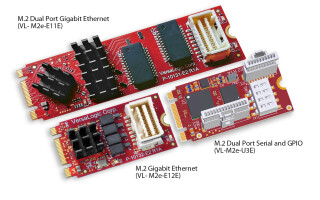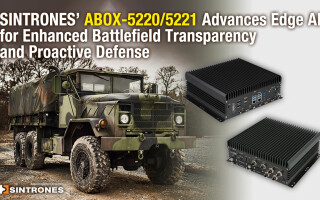Application-ready platform choices expand rugged application possibilities
StoryJuly 04, 2015
Defense OEMs must find a way to cost-effectively meet mounting data throughput and processing needs with commercial off-the-shelf (COTS) platforms in smaller form factors. Application-ready systems that have been ruggedized for reliability in extreme military settings instill confidence with high availability by effectively addressing the significant power densities generated at the board, chassis, and system levels.
A growing number of military applications can benefit from employing capabilities similar to high-performance commercial PCs, which can be seen in data recorder systems that now utilize high-bandwidth 10 gigabit Ethernet (GbE) connectivity, giving military personnel the ability to load/upload and offload data quickly. Yet the task of making these systems rugged enough for military use is not without difficulty, and part of the problem is that high-speed signals such as USB 3.0, 10 GbE, and optical interconnects are not easily ruggedized. Ruggedizing for military environmental conditions, space constraints, and overall signal integrity is much more challenging than commercial connector solutions are built to handle. The equation is made even more complex when you consider that rugged computing that supports reliable signal integrity must also incorporate robust software implementation, smaller form factors, optimized BIOS, and trusted removable storage in sealed enclosures.
To satisfy all these demands, rugged computing must incorporate a multidiscipline approach in order to be effective. While there is no single option that fits all applications, there are a range of trusted COTS-based platforms that have a proven track record in military deployments. Helping further is the notion that most platforms can also act as modular building blocks to streamline development resources and timelines. For example, VME – still a predominant bus architecture – has evolved to the point where it now supports the latest x86 and field-programmable gate array (FPGA) processor architectures. Moreover, embedded computing platforms based on computers-on-module (COMs) are available as prevalidated systems, allowing developers to add integrated video processing and display features; compute performance is readily optimized for graphics-heavy imaging and sensor data processing applications without affecting rugged operation. In addition, prevalidated, microprocessor-based VPX platforms can deliver high-performance parallel processing using mainstream protocol such as PCIe Gen 3 and 10 GbE.
Using a modular platform approach enables developers to maintain compatibility and interoperability for many types of rugged applications ranging from ground vehicle systems and shipborne computing to manned airborne and unmanned aerial vehicle (UAV) payloads.
VME still stands strong
While industry experts have long predicted VME’s demise, it’s not dead yet and remains a popular bus and board architecture standard. Still highly reliable for mission-critical embedded systems, VME also enjoys a huge installed base of systems, supported by a broad and experienced ecosystem of suppliers. As a result, many legacy military programs will choose to keep VME when upgrading or refreshing established systems. In the current budget-conscious defense environment, it would be rare for a large program to make an architecture change, based on the high cost of replacing existing VME chassis, I/O cards, and software.
Even though continual enhancements to bandwidth, connectors, and I/O options have kept the familiar VME in the running, performance limitations on throughput are coming to light. Because of these issues, defense contractors are always looking for cost-effective solutions to maintain this trusted technology investment. Today, VME-based platforms are innovating by using FPGA technology that enables PCI-to-VME bridging, making VME more immune to silicon obsolescence. Also keeping VME-based systems relevant is suppliers’ ability to offer effective processor migration for both PowerPC and x86, along with new integrated health-management capabilities.
VPX is application-ready and high bandwidth
3U Open VPX-based High Performance Embedded Computing (HPEC) platforms, in both air- and conduction-cooled options, capably support military systems operating within harsh environmental conditions. These types of systems are developed to be completely application-ready while supporting server class applications. A small 3U footprint and rugged technologies enable server consolidation that can simplify logistics, installation, and maintenance of complex military systems. Airflow temperature is controlled on each slot, while payload boards can be held in standby mode to meet low-energy surveillance requirements. Server-class silicon means that military field operations can readily utilize data center features such as libraries, middleware, and other technologies that have been optimized for rugged application conditions. Virtualization helps future-proof the VPX platform investment, allowing a single application to be easily adapted to hardware evolution needs such as CPU count, memory, form factor, and I/O availability. These application-ready systems combine dual ports of integrated 10 GbE and integrated I/Os (PCIe, USB, SATA, and other general purpose I/Os) into a single system for maximum efficiency.
It’s important to note this platform also offers central health and power-management capabilities. For developers, this adds value in meeting sensor data processing requirements in space-constrained systems.
COMs-based platforms deliver small-footprint, application-ready advantages
The basics of COMs-based design enable modules to be switched out without affecting carrier-board customization; these attributes also ensure long life cycle support for customized military and space systems. The carrier-board design maximizes system capabilities while minimizing overall size so that the resulting system balances performance and footprint for applications that routinely require limited physical space. These same platforms integrate the latest x86 processors so that system performance can also evolve with processor-architecture advancements by swapping out modules. This reality means that total cost of ownership is managed for long-term value as future upgrades are simplified, while developers avoid costly and time-consuming design requalification.
One such system is the Kontron COBALT, a rugged small-form-factor system based on COMs (Figure 1). COBALT’s IP67 chassis operates in harsh conditions including extreme temperatures, shock, vibration, and electromagnetic interference (EMI). Sealed IP67 systems are expressly developed to support highly-rugged applications such as vehicle- or helicopter-based computing. The device’s integrated video processing, display, and other features are designed not to affect rugged design considerations. For instance, its onboard Rapid Shutdown circuit design protects systems by enabling survivability from extreme episodes such as high-energy electromagnetic pulse (EMP).
Figure 1: The Kontron COBALT, which uses a 3rd-generation Intel dual core-based COM Express Type 6 module is targeted at harsh and operationally demanding military and aerospace applications.
(Click graphic to zoom by 1.8x)
Effective thermal management by design
Why are application-ready systems so effective in managing thermal issues? All of the required system functionality is implemented in a chassis that has been precertified for ruggedized operation rather than simply listed as “designed to meet.” Developers can incorporate a chassis that is manufactured to meet MIL-E-5400 Class 1 thermal performance, MIL-901D shock or MIL-STD-810F vibration requirements, in turn assuring the system’s ability to withstand specified these same environmental extremes. Since robust design components are built in, it reduces the need for additional development resources, all housed in a sealed and temperature-controlled enclosure that offers ultimate protection for its internal computing elements and electronics.
A case in point are select small-form-factor COMs-based platforms that provide extended thermal characteristics “by design.” These platforms employ a reengineered COM optimized for proven performance in extended temperature applications. They also bring up a common myth in systems packaging: the assumption that radiation plays a marginal role in cooling electronic equipment. While this statement remains true for higher-power systems requiring high levels of power dissipation, defense-system developers must pay closer attention to the effects of radiative cooling in passively cooled convection systems operating within low power requirements. As smaller, lower-power systems carve out and expand their niche in military electronics, radiation can impose significant restrictions on where they can be deployed. Systems that offer a passive convection alternative can deliver both scalability and excellent power dissipation in a sealed system. By integrating cooling capabilities into the size, weight, and power (SWaP) protocol, packaging engineers then have access to more sophisticated SWaP plus cooling) considerations early in the development process.
Achieving rugged design versatility
While no single rugged computing platform fits every need for modern military and aerospace networking and imaging applications, application-ready systems can provide a head start in a number of design scenarios. Designers can select from multiple “ruggedized” and proven options depending upon requirements, time frame, budgets, time to market, and anticipated future needs. Design success depends on selecting the right platform for the job, one that ensures confidence in mission-critical military operations. VME may be the best fit to meet legacy requirements via new FPGA functionality, whereas VPX offers some of the most rugged performance options in higher bandwidth systems. Moreover, systems that demand more flexible, scalable features can capitalize on the inherent value of COMs to enable a full complement of I/O options, reduce precious SWaP, and trim costs. In addition, many of these platforms also offer the ability to use and re-use prevalidated designs, giving a significant competitive advantage in meeting design requirements while reducing development resources and avoiding additional customization costs.
Reducing design risk and enabling increased design versatility is essential to the evolving, modern battlefield that continues to call for increased computational performance and communication bandwidth improvements. Enabling a small-footprint, low-power, and cost-saving answer for rugged applications, platforms that feature efficient thermal design support additional development flexibility while delivering essential fanless operation in severe environments. Designers looking for sustainable, long-term design that meets specified deployment life cycles will find a number of application-ready embedded computing platforms designed to support extreme rugged reliability, both now and when the need arises for future power or performance advances in the same small footprint.
RJ McLaren is the Portfolio Manager for the Avionics, Defense and Transportation business unit at Kontron. He is responsible for product and business development for rugged systems along with Kontron’s industry-standard COMe, AMC, CompactPCI, VME, and VPX product lines. He can be contacted at rj.mclaren@us.kontron.com.
Kontron www.kontron.com
Sidebar 1
(Click graphic to zoom by 3.0x)








